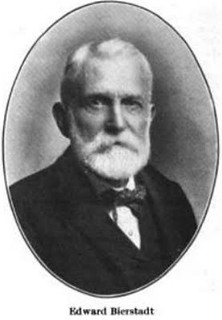
PREV ARTICLE
NEXT ARTICLE
FULL ISSUE
PREV FULL ISSUE
EDWARD BIERSTADT (1824-1906)John Lupia submitted the following information from the online draft of his book of numismatic biographies for this week's installment of his series.
Thanks! As always, this is an excerpt with the full article and bibliography available online. This week's subject is early coin photographer Edward Bierstadt. -Editor
Edward and his older brother Charles Bierstadt (1819-1903), operated a photograph business inventing new techniques and devices as early American pioneers in photography. In 1859, he and his brother Charles opened an art studio at 39 Purchase Street, New Bedford, Massachusetts. In 1870, he moved to New York working in their photograph studio at 545 Broadway producing their Albertypes. In 1877, he opened a new studio on Reade Street, which later on was renumbered from 58 & 60 to 94, where he remained for 29 years selling paintings, engravings and stereoscopic images stamped with their company name "Bierstadt Brothers" and the Photo-Plate Printing Company, which was later on renamed the Artotype Printing Company. Albert rented a painting studio in the Tenth Street Studio Building. In 1876, for the U. S. Centennial, he patented a new stereoscope. In 1880, he developed a process to make color photographs but the process took several days.  Edward Bierstadt, 58 & 60 Reade Street, New York City, New York, correspondence with the Chapman Brothers regarding photographic plates, postmarked April 12, 1884. Note the handwriting appears distinctively different from his hand below in 1895/1896 and is probably that of his wife Adeline. He and Theo De Vinne invented a mechanical overlays for halftones. In 1894, he developed a new process for color photographs from life that took only 10 minutes.
[AT RIGHT] Edward Bierstadt correspondence with the Chapman Brothers informing them he will send them their plates sometime first week of January 1896. Courtesy Lupia Numismatic Library, Special Collection, The Chapman Family Correspondence Archive. He died on June 15, 1906. He is buried at Woodlawn Cemetery, Bronx, New York. To read the complete article, see:
Wayne Homren, Editor The Numismatic Bibliomania Society is a non-profit organization promoting numismatic literature. See our web site at coinbooks.org. To submit items for publication in The E-Sylum, write to the Editor at this address: whomren@gmail.com To subscribe go to: https://my.binhost.com/lists/listinfo/esylum All Rights Reserved. NBS Home Page Contact the NBS webmaster 
|

